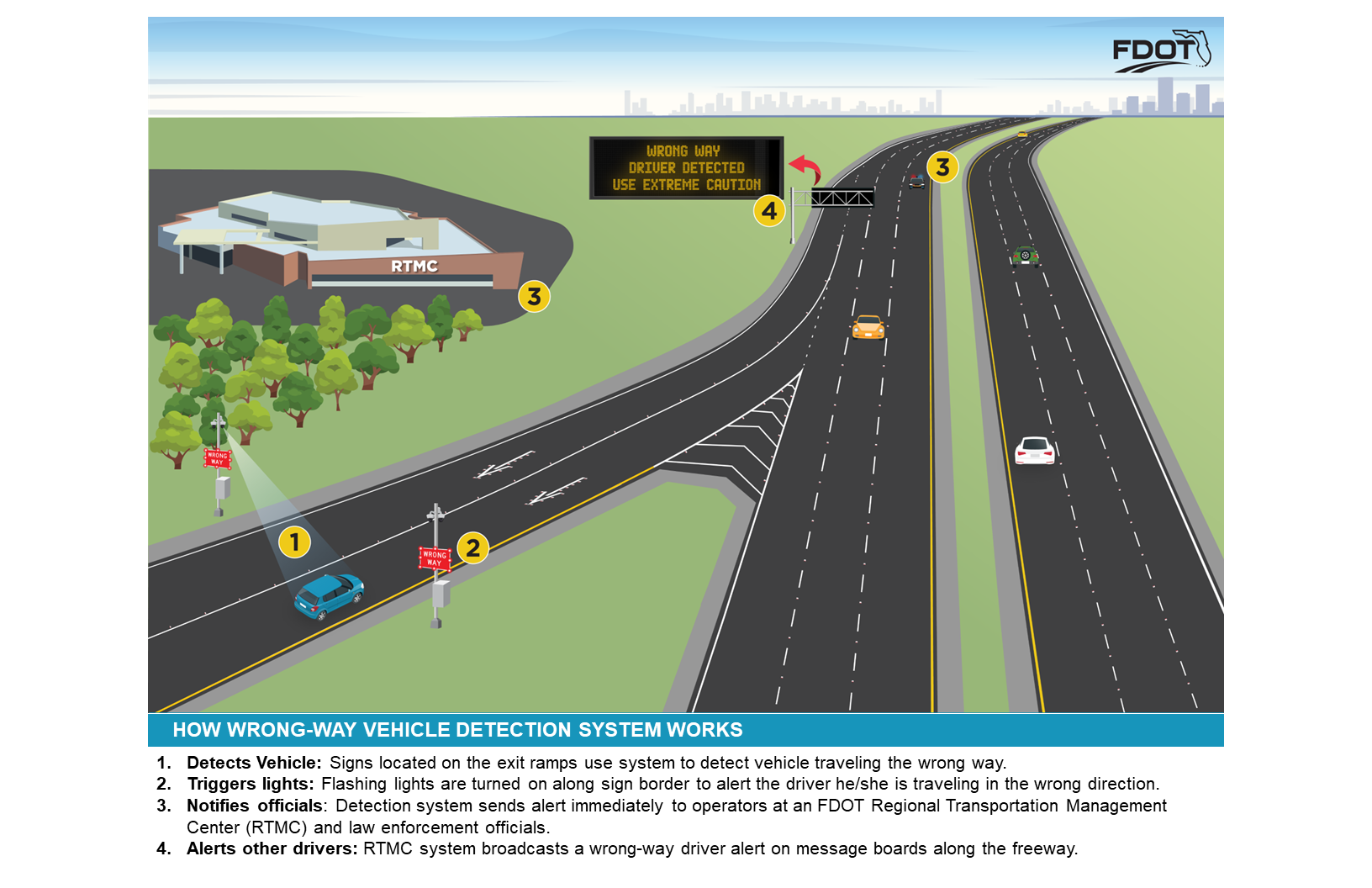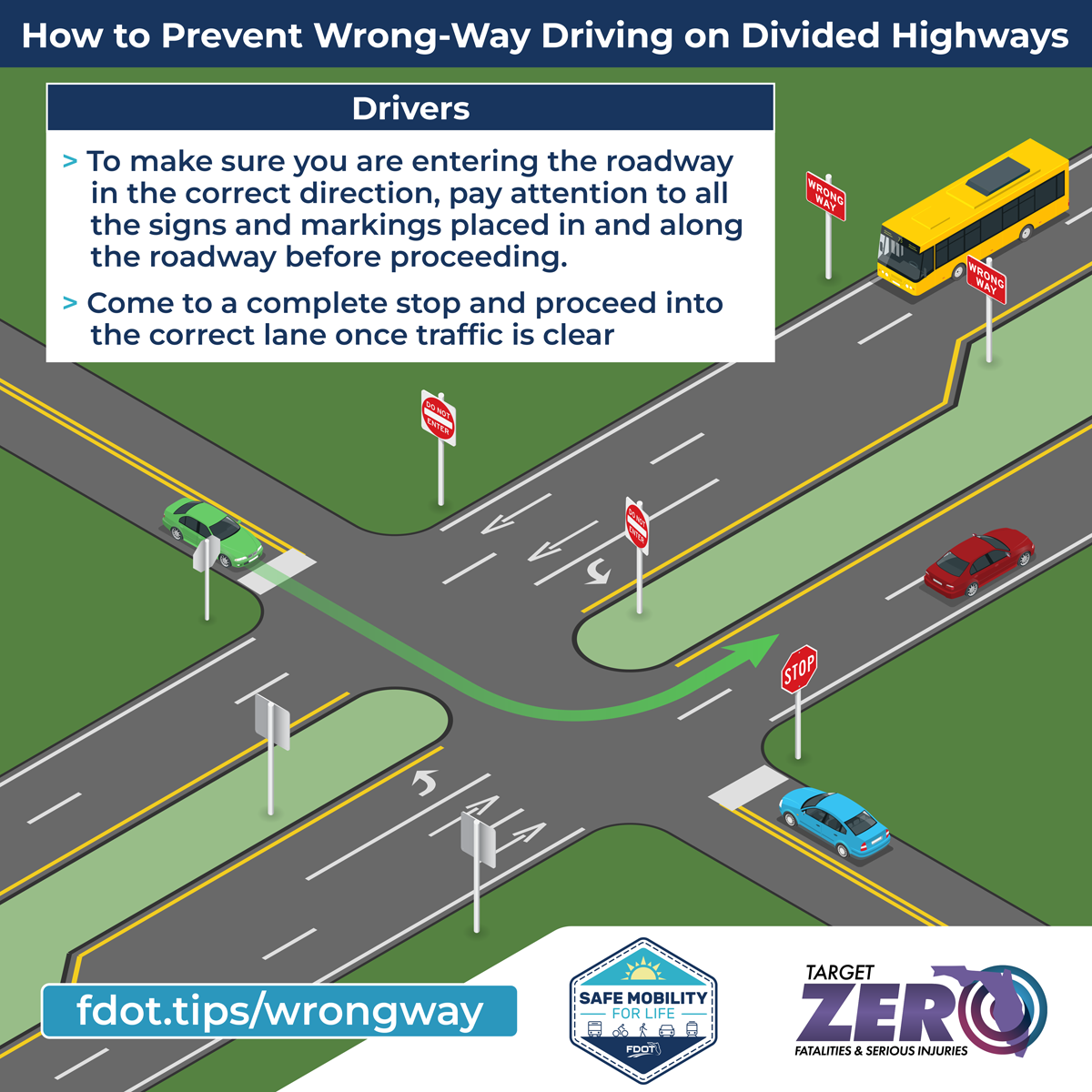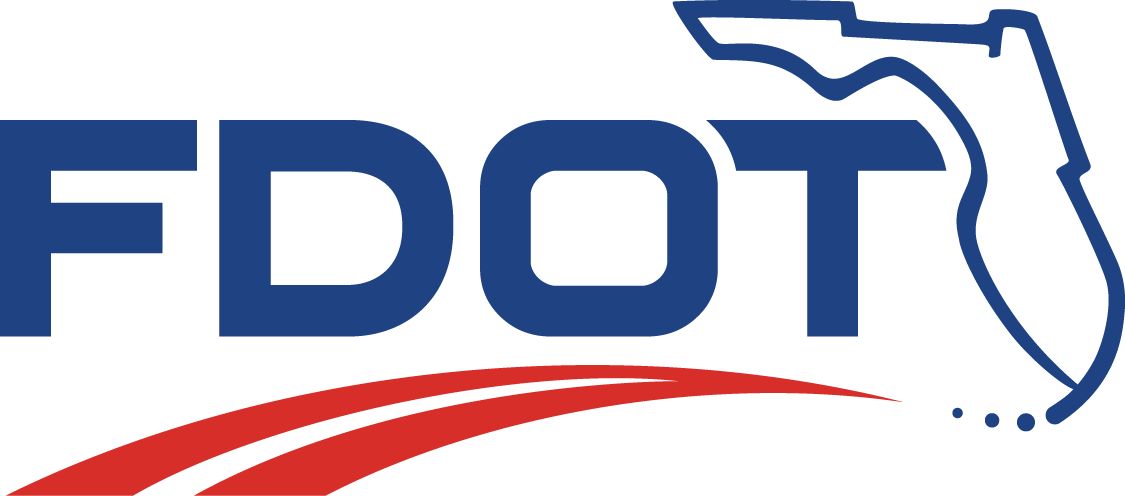FDOT's Wrong-Way Driving (WWD) Program
Research | Countermeasures | Education | Frequently Asked Questions

While wrong-way driving crashes occur randomly and less frequently than other types of crashes, they often involve more than one vehicle and can result in multiple fatalities and/or serious injuries.
FDOT installs the minimum required DO NOT ENTER and WRONG WAY signs and pavement markings (wrong-way arrow, etc.) in accordance with the federal Manual on Uniform Traffic Control Devices (MUTCD). However, FDOT also installs additional signing and pavement marking requirements as referenced in the following FDOT documents:
- Wrong-Way Signs and Pavement Markings: Section 230.4 of the FDOT Design Manual (FDM)
- Previous Bulletins:
- Signing and Pavement Marking Standards at Ramp Intersections: Roadway Design Bulletin 15-08/ Traffic Operations Bulletin 03- 15.
- Wrong-Way Driving Advanced Countermeasures at Interchange Exit Ramps: Traffic Engineering and Operations Bulletin 19-03.
- Wrong-Way Driving Countermeasures for Arterials and Collectors: Traffic Engineering and Operations Bulletin 21-03
Supported by research, FDOT’s Wrong-Way Driving Initiative explores various WWD countermeasure systems to aid in warning wrong-way drivers, sending notifications to alert other motorists and notifying law enforcement. Watch the video below to learn more about this initiative.
The WWD Initiative supports the FDOT’s commitment to achieving zero fatalities and serious injuries on the State Highway System.
Strategic Plan
Please see the latest Wrong Way Driving Strategic Plan below.
- Wrong Way Driving Strategic Plan - 02/05/2025
Research
Prior to implementation, FDOT conducted statewide studies and various research projects to help analyze WWD trends and contributing factors, determine the effectiveness of various countermeasures and test those countermeasures. Additional research conducted by FDOT focused on addressing the factors that were considered to affect the occurrence of WWD incidents: Impaired drivers, drivers aged 65 years and older, and tourists. Findings from this study provide guidance to proactively deploy WWD countermeasures at all the off-ramps in Florida. Detailed information on these research projects can be found by clicking on the links below:
- Statewide Wrong-Way Crash Study
- Driving Simulator Studies of the Effectiveness of WWD Countermeasures
- Comparing Countermeasures for Mitigating Wrong-Way Entries onto Limited Access Facilities
- Testing and Evaluation of Freeway WWD Detection Systems
- A Data-Driven Approach to Implementing WWD Countermeasures
Countermeasures
During FDOT’s statewide study, off-ramps were identified that could be associated with higher rates of WWD entries.
FDOT evaluated several countermeasures from the research projects and found the Light-emitting Diode (LED) Highlighted WRONG WAY Sign (R5-1a) to be one of the most effective. These enhanced highway sign assemblies are part of a Wrong-Way Driving Alert System designed to:
- Detect when vehicles are traveling in the wrong direction.
- Activate the lights on the sign to notify the driver.
- Send an immediate alert to officials.
- Broadcast an alert on electronic message boards to alert upstream drivers.
An example of how the Wrong-Way Driving Alert System works on the roadway can be seen in the images below.


Education
One of FDOT’s overarching strategies in Florida’s Strategic Highway Safety Plan is Education. FDOT strives to improve public awareness of highway safety and increase motorists’ understanding of engineering solutions and best practices that can reduce the injury severity and number of crashes.
Wrong-Way Driving: What You Need to Know

Whether driving on the interstate, local, or state roads, all drivers must do the following if they approach a WRONG WAY sign to help prevent a crash:
- Stop immediately.
- Pull over to the side of the road.
- Turn around when it is safe to do so.
If a driver encounters a wrong-way driver or sees an alert displayed on an electronic message board, they should take the following actions:

- Use caution.
- Reduce your speed.
- Pull over.
- Call 911 to report.
The signage and markings that drivers may encounter on roadways is consistent across the state of Florida. Review the information below to understand what each sign and marking means and how to respond as a driver.
Together We Can All Get There Safely – Wrong Way Driving PSA.


FDOT created print and digital materials to educate drivers on the specific WWD countermeasures for the Interstate system. These materials inform drivers on what to do if they enter a ramp the wrong way or encounter a wrong-way driver on the roadway.
You can download and order copies of this tip card from the Safe Mobility for Life Resource Center. Digital graphics can be downloaded from the Safe Mobility for Life Outreach page.

Additional Information

